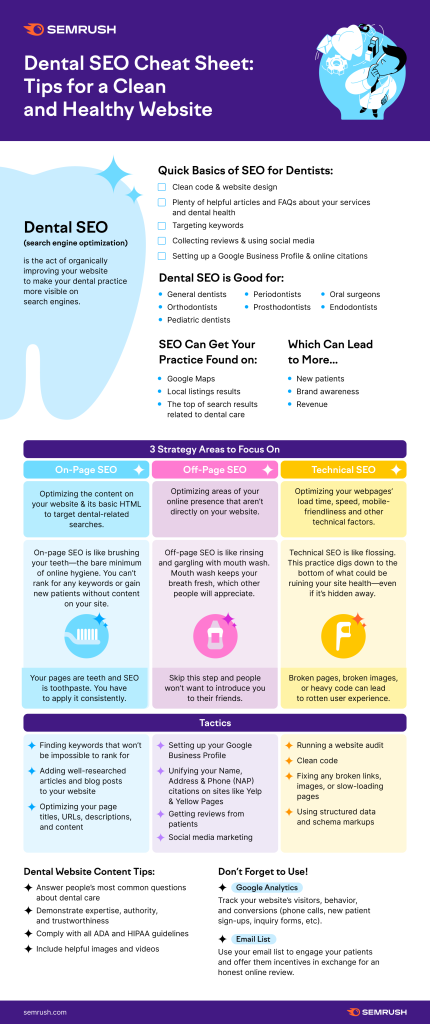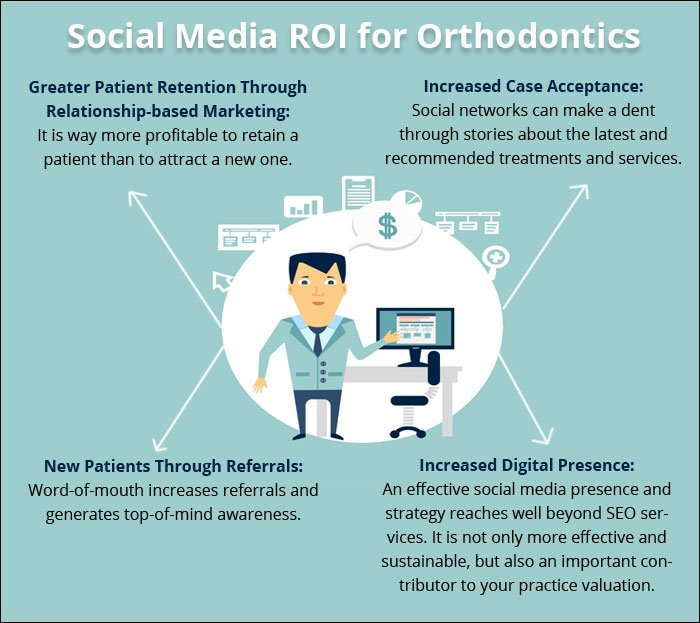Have you ever wondered how to improve your website’s visibility and attract more patients as an orthodontist? Well, look no further because today we’re going to talk about content SEO best practices specifically tailored for orthodontists. Whether you’re just starting out or looking to optimize your existing website, these tips will help you rank higher in search engine results and ultimately drive more traffic to your practice.
When it comes to content SEO for orthodontists, one of the most important things to consider is keyword research. By identifying the keywords and phrases that potential patients are using to search for orthodontic services, you can strategically incorporate them into your website’s content. This will not only help search engines understand what your website is about, but also increase the chances of your website appearing in relevant search results.
Another crucial aspect of content SEO is creating valuable and informative content. Gone are the days when simply stuffing your website with keywords would do the trick. Nowadays, search engines prioritize websites that provide high-quality and relevant content to their users. By regularly publishing articles, blog posts, and even videos that address common orthodontic concerns and offer helpful tips, you can establish yourself as an authority in your field and attract more visitors to your website.
In addition to keyword research and creating valuable content, optimizing your website’s technical aspects is also important for SEO. This includes optimizing your website’s loading speed, ensuring it is mobile-friendly, and optimizing meta titles and descriptions. These technical optimizations not only improve user experience, but also send positive signals to search engines, increasing the chances of your website ranking higher in search results.
In conclusion, by implementing these content SEO best practices for orthodontists, you can improve your website’s visibility, attract more patients, and ultimately grow your practice. In the upcoming article, we’ll delve into each of these topics in more detail, providing you with actionable tips and expert advice. So, stay tuned and get ready to take your orthodontic practice to the next level with content SEO!

Introduction to SEO for Orthodontists
In today’s digital age, having a strong online presence is essential for any business, including orthodontic practices. When potential patients are searching for orthodontic services, they often turn to search engines like Google. Therefore, it is crucial for orthodontists to implement effective Search Engine Optimization (SEO) strategies to ensure that their practice website appears at the top of search results.
What is SEO?
SEO refers to the process of improving a website’s visibility and ranking on search engine results pages (SERPs). By optimizing their website and content, orthodontists can increase their chances of being found by potential patients when they search for keywords related to orthodontic treatments or services.
Why is SEO important for orthodontists?
Orthodontists face fierce competition, and without a solid SEO strategy, their practice may go unnoticed by potential patients. By investing in SEO, orthodontists can increase their online visibility, attract more organic traffic to their website, and ultimately, generate more leads and appointments.
Benefits of SEO for orthodontists
Implementing SEO best practices can yield numerous benefits for orthodontic practices. Some of the key advantages include:
-
Increased online visibility: SEO helps your practice website rank higher in search engine results, making it more likely for potential patients to find and visit your website.
-
Targeted traffic: SEO allows you to target specific keywords and phrases related to orthodontic services, ensuring that the traffic coming to your website is relevant and more likely to convert into appointments.
-
Better user experience: SEO involves optimizing your website’s design, structure, and content to provide a seamless and enjoyable user experience. This, in turn, can improve user engagement and increase the chances of visitors becoming patients.
-
Cost-effective marketing: Compared to traditional forms of advertising, such as print ads or billboards, SEO provides a cost-effective way to promote your orthodontic practice. Once your website is optimized, the ongoing cost of maintaining and updating your SEO strategy is relatively low.
-
Long-term results: While SEO does require time and effort to implement, the results can be long-lasting. With consistent effort, your practice can maintain a strong online presence and continue attracting new patients over an extended period.
Keyword Research and Optimization
Importance of keyword research for orthodontists
Keyword research is a fundamental aspect of SEO. By identifying the keywords that potential patients are using to search for orthodontic services, you can optimize your website’s content to align with these search queries. Conducting keyword research allows you to understand the language and terminology used in your industry and tailor your content accordingly.
Tools for keyword research
There are several tools available that can assist orthodontists in their keyword research efforts. These tools provide valuable insights into the search volume, competition, and relevance of specific keywords. Some popular keyword research tools include:
- Google Keyword Planner
- SEMrush
- Moz Keyword Explorer
- Ahrefs
By using these tools, you can uncover the most relevant and high-value keywords that will help your practice rank higher in search results.
Identifying relevant keywords for orthodontic practices
When conducting keyword research, it is essential to focus on terms and phrases that are specific to orthodontic treatments and services. This includes keywords such as “orthodontist,” “braces,” “Invisalign,” and “teeth alignment.” Additionally, considering location-specific keywords like “orthodontist in Philadelphia” can help attract local patients.
Optimizing website content with targeted keywords
Once you have identified the relevant keywords for your orthodontic practice, it’s time to optimize your website’s content. Incorporate these keywords strategically throughout your website’s pages, including the homepage, service pages, and blog posts. However, it’s important to maintain a natural flow and avoid keyword stuffing, as search engines may penalize your website for this practice. Focus on creating high-quality, informative content that addresses the needs and questions of potential patients.
Implementing keyword strategy in meta tags and headings
In addition to optimizing your website’s content, pay attention to meta tags and headings. Meta tags, including the meta title and meta description, are the snippets of text that appear in search engine results. These should include relevant keywords and accurately summarize the content of each webpage.
Headings, on the other hand, help organize your content and make it more scannable for both users and search engines. Incorporate keywords naturally into your headings to improve readability and optimize your website for SEO.

On-Page SEO for Orthodontists
Creating compelling and informative website content
When it comes to on-page SEO, high-quality content is key. Create informative and engaging content that educates potential patients about orthodontic treatments, addresses common questions and concerns, and highlights the benefits of your practice. Use a friendly and approachable tone to establish a connection with your target audience.
Optimizing HTML tags for orthodontic keywords
HTML tags, such as title tags and meta descriptions, play a significant role in SEO. Ensure that your title tags accurately describe each webpage and include relevant keywords. Meta descriptions should be informative and enticing, encouraging users to click on your website in search results.
Improving website loading speed
Website loading speed is not only crucial for user experience but also for SEO. A slow-loading website can lead to higher bounce rates and fewer conversions. Optimize your website by reducing file sizes, leveraging browser caching, and compressing images to improve loading times.
Including relevant multimedia content
Visual content, such as images and videos, can enhance user engagement on your website. Include relevant multimedia content that supports your orthodontic services and provides additional value to visitors. Optimize images by compressing them to reduce file sizes and adding alt tags that include relevant keywords.
Ensuring mobile-friendly website design
With the increasing use of smartphones and tablets, it is vital to ensure that your orthodontic practice website is mobile-friendly. A responsive website design ensures that your website adapts and displays correctly on different devices, improving user experience and SEO.
Off-Page SEO for Orthodontists
Building high-quality backlinks from reputable websites
Backlinks from reputable and authoritative websites can significantly improve your website’s SEO. Seek opportunities to collaborate with other dental professionals, industry influencers, and local organizations to earn backlinks. Building a network of quality backlinks demonstrates to search engines that your website is trustworthy and relevant.
Social media marketing for orthodontic practices
Social media platforms provide an excellent way for orthodontists to connect with their target audience and promote their practice. Share informative content, engage with followers, and encourage them to visit your website for more information or to schedule an appointment.
Local business directory listings
Listing your orthodontic practice in local business directories improves your local SEO. Ensure that your practice is listed accurately and consistently across various directories, including your NAP (Name, Address, Phone) information. This consistent information helps search engines understand your location and improve your local search rankings.
Online reputation management
Maintaining a positive online reputation is crucial for attracting new patients. Encourage satisfied patients to leave reviews and testimonials on platforms such as Google My Business, Yelp, and Facebook. Respond promptly to both positive and negative reviews, demonstrating your commitment to patient satisfaction.
Influencer collaborations and guest blogging
Collaborating with influencers or guest blogging on relevant websites can increase your practice’s visibility and credibility. By sharing your expertise and insights, you can reach a broader audience and gain exposure within the orthodontic community.

Website Optimization for Local SEO
Claiming and optimizing Google My Business listing
Claiming and optimizing your Google My Business (GMB) listing is essential for local SEO. Verify your practice’s details, including name, address, phone number, and operating hours. Add high-quality photos, respond to reviews, and regularly update your GMB profile with relevant information about your services.
Consistent NAP (Name, Address, Phone) information across all platforms
As mentioned earlier, maintaining consistent NAP information across all online platforms is crucial for local SEO. Inaccurate or inconsistent information can confuse search engines and potential patients. Regularly audit your practice’s listings and update any changes promptly.
Optimizing website for local keywords
Incorporating local keywords throughout your website helps search engines understand your geographical relevance. Target keywords such as “orthodontist in Philadelphia,” “Philadelphia braces,” or “Invisalign in Philadelphia.” Create location-specific content, including blog posts or landing pages that provide valuable information for potential patients in your area.
Encouraging online reviews and testimonials
Positive online reviews and testimonials have a significant impact on attracting new patients. Encourage your satisfied patients to leave reviews on platforms like Google, Yelp, and Healthgrades. Responding to reviews, whether positive or negative, shows your dedication to patient satisfaction and helps build trust with potential patients.
Implementing local schema markup
Schema markup is a code that you can add to your website to provide search engines with additional information about your practice. Implementing local schema markup helps search engines understand your business’s location, opening hours, reviews, and other essential details. This can improve your website’s visibility and prominence in local search results.
Technical SEO for Orthodontists
Ensuring website crawlability and indexability
Search engines need to crawl and index your website’s pages to include them in search results. Ensure that there are no technical barriers, such as broken links or excessive use of Flash or JavaScript, that prevent search engines from properly crawling and indexing your website.
Proper URL structure and navigation
A clear and logical URL structure helps both search engines and users navigate your website. Use descriptive keywords in your URLs and organize your content into user-friendly categories and subcategories.
Optimizing website architecture
A well-organized website architecture improves user experience and SEO. Arrange your website’s pages in a hierarchical structure, with the most important and relevant pages accessible within a few clicks from the homepage. This helps search engines understand the structure of your website and prioritize relevant content.
Implementing structured data markup
Structured data markup allows you to provide additional context and information about your content to search engines. Adding structured data markup to your website can enhance search engine visibility and potentially lead to rich snippets in search results, such as star ratings or business information.
Using XML sitemaps and robots.txt
XML sitemaps help search engines crawl and index your website more efficiently. By creating and submitting a sitemap, you ensure that all relevant pages of your website are included in search engine indexes. On the other hand, robots.txt allows you to control which pages search engines can or cannot crawl.

User Experience and SEO
Responsive website design for different devices
Creating a responsive website design ensures that your website looks and functions correctly on different devices, including desktops, smartphones, and tablets. Responsive design improves user experience, encourages longer visit durations, and reduces bounce rates.
Improving website usability and navigation
A user-friendly website is crucial for both user experience and SEO. Ensure that your website is easy to navigate, with clear navigation menus and logical page structures. Use descriptive anchor texts for internal links and include a search function to help users find the information they need.
Optimizing website for faster load times
Website loading speed has a significant impact on both user experience and SEO. Optimize your website’s performance by compressing images, minimizing code, and leveraging caching. Regularly monitor and improve your website’s loading times to ensure a positive user experience.
Clear and concise call-to-actions
Guide users towards desired actions, such as booking an appointment or contacting your practice, by incorporating clear and concise call-to-action buttons throughout your website. Ensure that these buttons stand out and are easily accessible on both desktop and mobile devices.
Engaging and informative multimedia content
Incorporating engaging multimedia content, such as videos, infographics, and images, can improve user experience and increase time spent on your website. Ensure that any multimedia content is relevant, informative, and visually appealing.
Measuring and Tracking SEO Performance
Setting up Google Analytics for orthodontic websites
Google Analytics provides valuable insights into the performance of your website by tracking various metrics, including website traffic, bounce rates, and conversions. Set up Google Analytics for your orthodontic website to monitor the effectiveness of your SEO strategies and make data-driven decisions.
Monitoring organic search traffic and conversions
Keep a close eye on organic search traffic to measure the impact of your SEO efforts. Monitor the number of visitors coming from search engines and track the conversions generated from organic traffic, such as appointment requests or form submissions.
Analyzing keyword rankings and SERP visibility
Regularly check your keyword rankings in search engine results to assess your website’s visibility for targeted keywords. Use SEO tools to track your progress and identify areas for improvement. Additionally, analyze your website’s visibility in SERPs by monitoring features like local pack results, featured snippets, and knowledge graphs.
Using SEO auditing tools for website analysis
SEO auditing tools can help identify potential issues and areas for improvement on your website. Conduct regular audits to assess your website’s technical health, on-page optimization, backlink profile, and overall SEO performance.
Adjusting strategies based on data insights
Data from analytics and SEO tools should guide your decision-making process. Use the insights gained from data analysis to refine your SEO strategies, optimize your website, and focus on tactics that yield the best results.

SEO Trends and Future Considerations for Orthodontists
Voice search optimization
The rise of voice assistants and smart speakers has led to an increase in voice search queries. Optimize your website content for voice search by targeting long-tail keywords and incorporating natural language phrases into your content.
Mobile-first indexing
Google now prioritizes the mobile version of a website for indexing and ranking. Ensure that your website is fully responsive and optimized for mobile devices to maintain your search engine visibility.
Artificial intelligence and machine learning in SEO
Search engines are increasingly relying on artificial intelligence and machine learning to understand user intent and deliver more relevant search results. Stay updated with industry trends and adapt your SEO strategies to align with advancements in search engine algorithms.
The importance of user intent in keyword targeting
Understanding user intent is crucial for effective keyword targeting. Focus on keywords that align with the specific needs and intentions of potential patients, ensuring that your website delivers the information and solutions they are seeking.
Staying updated with search engine algorithm changes
Search engine algorithms are constantly evolving, and staying up-to-date with these changes is essential for maintaining a strong SEO performance. Regularly check industry news, follow reputable SEO blogs, and adapt your strategies accordingly.
Conclusion
By implementing these SEO best practices, orthodontic practices can significantly improve their online visibility, attract more organic traffic, and generate more leads and appointments. Remember to conduct thorough keyword research, optimize your website’s content and structure, build high-quality backlinks, and prioritize user experience. Stay updated with the latest SEO trends and adapt your strategies based on data insights and search engine algorithm changes. With a strong SEO strategy in place, you can position your orthodontic practice for long-term success in the competitive digital landscape.

